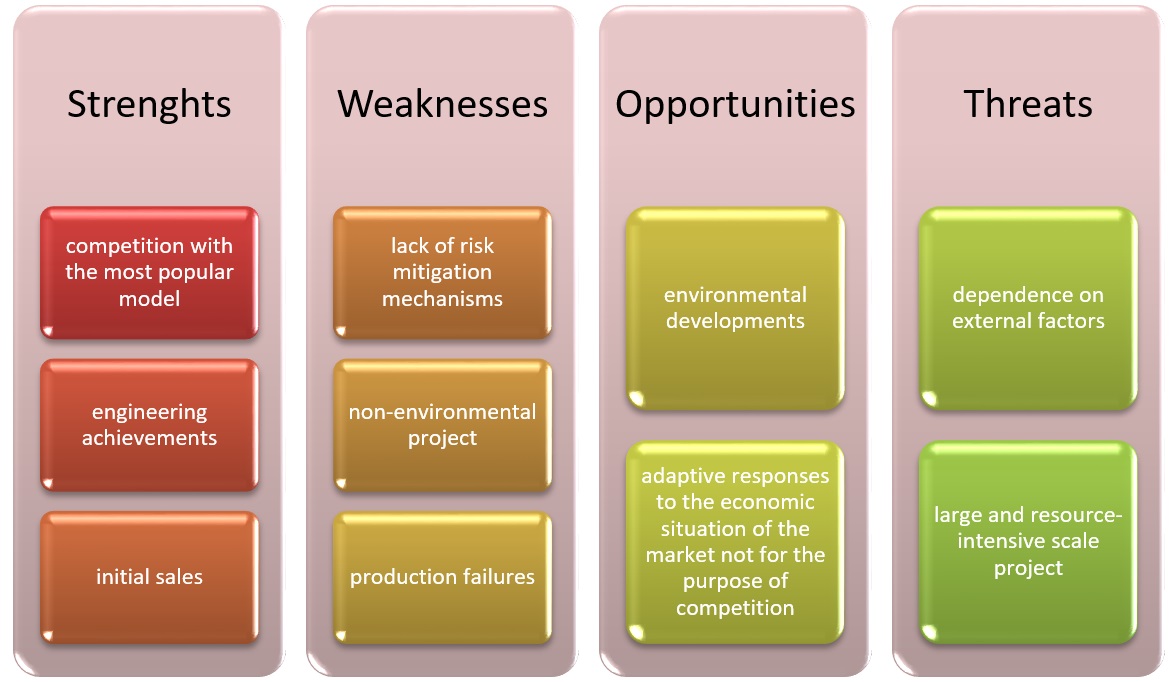Introduction
The Airbus A380 was an ambitious completed project for the largest passenger airliner in the world. The aircraft was designed to serve intercontinental airlines connecting the most major hub airports in Europe, Asia, Australia, and North America. Commercial operation of the Airbus A380 began in autumn 2007 (Airbus, n.d.). Unfortunately, such a significant engineering feat soon enough began to decline in sales. Experts point out that the airliner is too large, the capital intensity of its development, and the need to adapt the infrastructure to the unique dimensions of the aircraft (Baxter et al., 2018). However, the complexity of causes goes beyond the influence of anyone. Both external and internal factors influence the drop in sales of this model, and therefore in this paper it is proposed first to conduct a PESTLE analysis, reflecting the impact of infrastructure on sales, and then, based on it, a SWOT analysis will show the main threats to the project that led to this result.
PESTLE Analysis
Airbus announced its intention to end production of the A380 in February 2019. Order volumes for the model were falling due to airlines switching to smaller aircraft – large airliners were challenging to fill, and tight emissions regulations were pushing for such a transition (Bilbao, 2019). By then, Airbus had delivered 234 aircraft, less than half of the 600 aircraft projected at the start of production. Airbus estimates that the A380 aircraft have carried about 320 million passengers during their lifetime. The start of operation of the last aircraft produced coincided with the start of the pandemic in the world and the economic crisis, which only pushed Airbus to stop production. Thus, the fact that Airbus ceases production of the A380 model is not directly to blame for the COVID-19 pandemic. However, it is clear that the coronavirus has accelerated this step and made it inevitable.
First, it is worth noting the prerequisites associated with technological factors. Large aircraft emerged in response to projected market trends that extensive air travel would become the industry’s leading business model by the 1990s (Lincoln & Duong, 2019). However, due to the financial crisis of 2008, reducing the cost of operating large aircraft and switching to smaller and medium-sized models proved to be the most effective business plan. As the main competitor of Airbus, Boeing released the most popular model 747 much earlier, which managed to get more into the trends of that time. Airbus launched its A380 at the end of the significant jet era. The aircraft development process usually takes several years and requires significant capital investments. The market’s expected growth quickly reversed its direction during the crisis; hence, the Airbus A380 went against the tide – when the A380 peaked in orders, 747 were already cutting production.
The reason is economic factors: the fuel price has increased significantly, and the payback of large aircraft was highly dependent on their occupancy and passenger traffic. Against the background of this situation, many low-cost airlines began to open, which offered air transportation at a meager price, making this type of transportation comparable in price to land transport (Lincoln & Duong, 2019). These low-cost airlines practically did not fight with large companies due to the difference in target audience segments. However, creating a competitive environment ensured the influx of new passengers and tourists. At the same time, with the advent of the crisis, the purchasing power of the population began to decline, which is why even large companies had to adapt to the new market with pricing policies.
In addition, during the production of the A380, there were production failures, operational problems that required additional time or financial resources. As a result, the expected sales of the project would not fully pay off all the costs incurred by Airbus in the future. Competition with Boeing grew in a reactive progression: companies introduced products at an enviable rate without proper approbation and market research. At first, there was a pursuit for the number of passenger seats, then for the expansion or lengthening of the aircraft body itself. However, by 2010 many market leaders realized that small and medium-sized aircraft offered more flexibility and capability while maintaining customer satisfaction levels, and large aircraft was discontinued after that.
Social factors included moving away from the trend of hub flights towards point-to-point type transportation. Large airliners paid off their flights only with stops at different airports, building up their infrastructure around the world. Consequently, passengers could pay slightly less if the aircraft had an intermediate point where part of the cabin filling changed. As airports have developed in different regions, such flights have been justified by increased popularity and flow to the given infrastructure. However, economic factors turned out to be stronger than social ones: for the reasons stated above, airlines came to medium and small aircraft.
Political factors are linked to EU subsidies for Airbus and US subsidies for Boeing. The competition between the two companies went beyond the industry they operated. Legally, Airbus is so firmly bound by contracts for future orders, including options, that it was too late to abandon the production of the A380. In addition, when the idea was born, the trend towards the use of large aircraft was growing and expected further growth rates around the world.
Finally, environmental factors are no less important. The fight against greenhouse emissions gradually took on a global scale and reached the state-level authorities, who began to approve legal programs to reduce these emissions (Lincoln & Duong, 2019). Large liners emitted significantly more greenhouse gases into the atmosphere, and their further production required a revision of the process and technology. Without these environmental issues, the A380 project was far from payback, but new problems at the legislative level have significantly reduced the possible prospects for the project’s development. Figure 1 shows the PESTLE analysis in tabular form.

SWOT Analysis
The internal problems of Airbus are connected, first of all, with an incorrect assessment of the financial performance of the project. If it was pretty tricky to predict the transition to medium-sized and small-sized aircraft in large companies due to the crisis, then paying attention to possible risks was worth more. Airbus did not have mechanisms to mitigate the risks associated with delays and disruptions in production. Although the project had subsidized funding from the European Union and sales, the severe high cost of the project became apparent after some time, when the first models were taken into operation.
As a result, the project’s strengths lay in the engineering advantages of the new design, able to compete with the then most popular Boeing 747. Although the financing from the European Union was hidden, it was nevertheless ultimately positive for the company. Initial contract sales were quite good and promising. Weaknesses of the project include the lack of risk management mechanisms and the product’s complex production process with a large number of emissions into the atmosphere. Prolonged production with failures did not allow the company to break even after several years of supply.
The opportunities that were included in the project included the modification of production not only in order to compete with Boeing but also with the aim of more promising environmental developments. After the 2008 crisis and the growth of new low-cost airlines, Airbus should have stopped the production of large airliners earlier, following the example of Boeing, which had already begun to cut production before 2008 (Woo et al., 2021). In the aircraft manufacturing industry, adaptation to change cannot proceed at a fast pace since most of the processes are highly resource-intensive. After the cessation of production, Airbus used the opportunities to cooperate with China and are market leaders along with Boeing. The threats posed by this project included a strong dependence on external factors: airport infrastructure, customer purchasing power, fuel prices. Flexibility and ease of use took precedence over the grand scope of engineering, which the crisis of 2008 only accelerated, but by no means spawned.
This fact means that flexibility and adaptability in such a business, sooner or later, would still prove to be much better than increasing the scale of transportation. If not for the crisis of 2008, then a pandemic or other global events that affected the economy would have led to such changes, forcing politicians to act in the direction of restrictive measures, affecting the entire population of the earth without exception, as well as changing the vector of technological developments. The SWOT analysis of the project is shown in Figure 2.

References
Airbus. (n.d.) A380.
Baxter, G., Srisaeng, P., & Wild, G. (2018). The role of the airbus A380-800 aircraft in a full-service network airline’s commercial operations and route network design: the case of Thai airways international. Aeron Aero Open Access J, 2(4), 223-236.
Bilbao, I. O. How to optimize aerospace projects supply chain. Research and Education in Project Management (Bilbao, 2019), 41.
Lincoln, W., & Duong, L. (2019). Case 4: Airbus and the A380.
Woo, A., Park, B., Sung, H., Yong, H., Chae, J., & Choi, S. (2021). An Analysis of the Competitive Actions of Boeing and Airbus in the Aerospace Industry Based on the Competitive Dynamics Model. Journal of Open Innovation: Technology, Market, and Complexity, 7(3), 192.